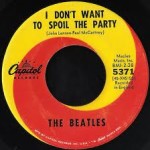A lot of Lennon & McCartney’s early songs were what you might call ‘genre’ songs. Their version of an R&B ballad (‘Yes It Is’), their version of a rootsy rocker (‘I Saw Her Standing There’), etc.
I’m always struck by how much originality they brought to each tradition they took on. There’s always a twist or two (or three), something that marks it as theirs and not just another song.
One of the ways they did this was by using II-V-I chord progressions in songs that were in the Rock & Roll and Country genres, where those chords were not so common.
Traditional Rock & Roll songs tended to be defined by IV-V-I progressions (which would be, in the key of ‘G’, the chords ‘C’ and ‘D’, resolving to ‘G’).
Harmonically you can substitute an ‘Aminor’ (II) chord for the ‘C’ chord, making it II-V-I instead of IV-V-I. The ‘Aminor’ would fit with almost any melody that would use the ‘C’ chord… but it wouldn’t feel as ‘Rock & Roll’. The use of a II chord, as opposed to the IV, feels a lot more ‘Great American Songbook’, ’jazzy’, traditional, or even Broadway.
In their period of apprenticeship, Lennon and McCartney played hundreds of songs from all these genres that preceded them. They had virtually all of Pop music history at their songwriting fingertips.
And when they wrote their own songs they didn’t limit themselves – they felt free to mix and match within genres. This not only made their writing more original, it also opened up this kind of eclecticism for generations of songwriters to come.
To demonstrate this, and in particular their still unusual mixture of II-V-I chords with more traditional Rock and Country chords, I’m going to look at a delightful song of theirs (which sounds like it was written primarily by Lennon), ‘I Don’t Want To Spoil The Party’. It’s an early Beatles version of a Country tune, which would normally be, and starts out being, fairly simple harmonically.
Not to say that Country songs are always simple chordally, but ‘I Don’t Want To Spoil The Party’ sounds harmonically rich even now, more than 50 years after it was written.
Listen below and play along. There are just two brief sections, one 8 bars, the other 6 bars, but they cover a lot of territory and, as with most Beatles compositions, these short 14 bars spawned thousands of other songs.
Like many Beatles tunes of this era, ‘I Don’t Want To Spoil The Party’ is written in an AABA form. The chords of the ‘A’ section:
|| G | G | G | D7 | Eminor B | Aminor D7 | G F | G ||
The first 4 bars are traditional; they could hardly be simpler. The following 4 bars, though, are full of surprises. The lushness of bars 5 and 6 is topped off with that unexpected ‘F’ chord in the 7th bar, before it resolves to ‘G’.
Note also that the melody in bars 7 and 8, though the same as in bars 1 and 2 (and almost the same as in bars 3 and 4), is made fresh by putting the ‘F’ chord underneath that pretty ‘E’ (a major 7) in the melody (instead of just staying on the ‘G’ chord, as the 1st and 3rd bars do).
The 6th bar contains the II-V-I (Aminor-D7-G) progression discussed earlier, which then gets explored even further in the expansive B section, brilliant in its apparent simplicity:
|| G | Eminor A | Aminor D7 | G | Eminor A | Aminor D7 ||
We get suckered in by the plain ‘G’ chord – the same one we’ve been hearing all along – which is then followed by II-V-Is in bars 2 & 3 and 5 & 6. Not typical in this genre, especially at the time, and bringing a joyous lift (“I still love her”) even now.
All of the harmonic moves discussed here are now available to any (and are in many) songwriters’ vocabulary. But it wasn’t always so. That’s why, when you make moves like this in your songs, mixing the harmonically simple and lush, expected and unexpected – but still rockin’ – it can sound… ‘Beatle-esque’.
Thanks for reading! Let me know your thoughts, additions, disagreements in the Comments section below:
And please share on facebook etc. by clicking the tabs beneath the video –


Wow, this shows you really dig deep und know what you are talking about. Thank you very much for sharing your insights!
Thank you, Wolfgang!
Great blog. Whenever I hear that “lushness,” I always think that’s a little bit of Paul – just like, for example, when “Getting better all the time” is followed by “it can’t get no worse” – hi, John.
Regarding this post, someone said something similar to me the other day. My response to them, and to you, is… don’t underestimate John in this area!
Great article. Yeah, I love that F chord in the first two verses and I didn’t realize about making it a major 7th.
Also, what is going on at the same time as all these chords and makes this one of my favorite Beatles songs is that they have their great unusual harmonies and the rocking drums in the middle part.
What a song. They certainly knew how to turn a simple thing into something special.
Thanks, Tony.
Thanks, Rich!
This is one of my favorite Beatles songs.